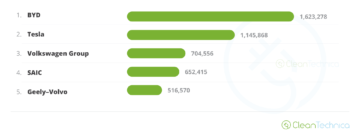Sign up for daily news updates from CleanTechnica on email. Or follow us on Google News!
Over the last couple of years, I’ve been chronicling the idiotic battle over remote vs in-person work. The pandemic and lockdowns broke a lot of assumptions people had been making about work, because companies simply didn’t have any choice in many cases. If they wanted to stay alive, they had to find a way to adapt to remote work.
One pleasant side effect of all this was that it cleaned up the air. Instead of having everybody and their dog commuting into work, and only “essential workers” had to report in. Previously polluted hellscapes became quite nice, human health improved, and people got to see just how bad things really were under normal times.
After the lockdowns ended, many companies decided to not go back to the old way. Workers were happier. Companies saved money on commercial real estate they had been renting that they didn’t really need to. This obviously couldn’t work for every job, but for the jobs it does work for, it’s great.
But, things can’t ever be simple. The move to remote work had some downsides, especially for cities. Without all of the people coming and going every day, city-based businesses found themselves with too few customers. Commercial real estate went into the toilet. Buildings sat vacant, or had whole floors vacant. Businesses that once served armies of cubicle workers didn’t have anybody to sell lunch or dry cleaning to.
This led to competing thoughts on how to deal with things. Traditionalists, including the increasingly conservative Elon Musk, railed against remote work. As always, a return to yesteryear is the way to go. Other people suggested converting the commercial real estate to housing, especially in places already suffering from housing shortages. Others tried to split the difference with hybrid work (come in some days, work remotely on others).
One of the big excuses we keep hearing is that remote work just isn’t the same. Being able to see people in person, they say, leads to better team building and collaboration. Also, concerns about getting enough face time with the bosses and whether that’ll hurt one’s career come up. But, putting in some more virtual meetings have shown improvements in that area, so it could be more about communication than physical presence.
There may be some good ways to take this to the next level, and a Lex Fridman interview from a couple months ago with Mark Zuckerberg shows us what part of it might be.
[embedded content]
By taking VR, adding face and body tracking, and adding eye tracking, super-realistic avatars can be made. At present, it requires body scans and the best available headsets ($1000) to accomplish this, but as with everything, the technology can trickle down over time, and often faster than we think.
At present, the commercially-available avatar experience is still fairly good, even if it’s still cartoony. Most importantly, the ability to see other people’s eyes and facial expressions still makes for a much better social experience, even without the high realism from the Lex Fridman interview.
Besides, I kind of like my space-suited avatar! There’s an app in the Quest 2 that lets you customize it in front of a mirror in 3D, and seeing it move in the mirror is strangely realistic. It may sound strange, but after using it a few times, I start to feel like the cartoon really is me (which is slightly creepy in some ways, but still fun).
Plus, I don’t have to do makeup or get dressed, right?
One thing that they point out more toward the end of the interview is the psychological effect of this more realistic telepresence. Things like trust and a feeling of connectedness are a lot easier to foster between people who can see each other’s facial expressions. It’s just human instinct to favor those things. But, being able to do that more remotely takes us beyond what’s possible in Zoom meetings.
What About “Essential Work”?
Obviously, seeing people’s faces better from anywhere on the planet is only one part of the equation in the remote vs in-person work debate. Many jobs still require people to be there and manipulate things in person. Factory jobs, healthcare, food service, and many other things can’t be done remotely.
But, that might not be true forever. The ability to remotely control robots instead of going there in person could change things as the technology improves. We already have surgical robots, for example, and this has been done remotely in experiments. So, if something as sensitive as a surgery can happen remotely, many other tasks can also probably be done.
But, the real question is whether automation would just take the next step and leave remote robo-workers without jobs. That may happen (and could be a very good thing for humanity in the long-run), but it certainly won’t happen all at once. There are still some tasks that need to be performed by humans, at least part of the time.
Being able to use a mix of telepresence and automation could mean that robots do everything they can, and a person dials in to get a robot through troublesome tasks or to help when the AI system gets stuck. This is something already happening with AVs to a limited extent, and it’s been seen for a long time in science fiction.
So, we could ultimately find a whole new definition for “hybrid work”, even for hands-on tasks.
The Dystopian Side Of This
At the same time, never leaving the house does kind of suck. I work remotely, and I’ve had times where I don’t even leave to run errands for a few days in a row. The cabin fever feeling starts to creep in, and nobody wants that. I’ve found that VR really doesn’t solve that problem, either, because there’s a part of the mind that can’t be fooled by virtual experiences.
We really don’t want to become like the people in the 2009 film Surrogates.
But, I don’t think this is an excuse for forcing people to pointlessly commute, either now or in the future. Honestly, I’d rather make my time away from the house be for deeply meaningful things, like family dinners, travel to scenic destinations, and other enjoyable things in life. I’ve done the long-distance commute thing, and I’ve even worked as an Uber driver. Leaving the house for leaving the house’s sake isn’t the answer here.
Featured image by Jennifer Sensiba.
Have a tip for CleanTechnica? Want to advertise? Want to suggest a guest for our CleanTech Talk podcast? Contact us here.
CleanTechnica Holiday Wish Book
Our Latest EVObsession Video
[embedded content]
I don’t like paywalls. You don’t like paywalls. Who likes paywalls? Here at CleanTechnica, we implemented a limited paywall for a while, but it always felt wrong — and it was always tough to decide what we should put behind there. In theory, your most exclusive and best content goes behind a paywall. But then fewer people read it!! So, we’ve decided to completely nix paywalls here at CleanTechnica. But…
Thank you!
Advertisement
CleanTechnica uses affiliate links. See our policy here.
- SEO Powered Content & PR Distribution. Get Amplified Today.
- PlatoData.Network Vertical Generative Ai. Empower Yourself. Access Here.
- PlatoAiStream. Web3 Intelligence. Knowledge Amplified. Access Here.
- PlatoESG. Carbon, CleanTech, Energy, Environment, Solar, Waste Management. Access Here.
- PlatoHealth. Biotech and Clinical Trials Intelligence. Access Here.
- Source: https://cleantechnica.com/2023/11/29/vr-telepresence-takes-more-anti-remote-excuses-away/
- :has
- :is
- :not
- :where
- $1000
- $UP
- 15%
- 2009
- 36
- 3d
- a
- ability
- Able
- About
- accomplish
- adapt
- adding
- Advertise
- Affiliate
- After
- against
- ago
- AI
- AIR
- alive
- All
- already
- also
- always
- an
- and
- answer
- any
- anywhere
- app
- ARE
- AS
- assumptions
- At
- Automation
- available
- avatar
- Avatars
- away
- back
- Bad
- Battle
- BE
- became
- because
- become
- been
- behind
- being
- BEST
- Better
- between
- Beyond
- Big
- Bit
- body
- Body Tracking
- book
- bosses
- Broke
- Building
- buildings
- businesses
- but
- by
- CAN
- Career
- cartoon
- cases
- certainly
- change
- chip
- choice
- Cities
- Cleaning
- cleantech
- Cleantech Talk
- collaboration
- come
- coming
- commercial
- commercial real estate
- Communication
- Commute
- commuting
- Companies
- completely
- Concerns
- conservative
- content
- control
- converting
- could
- Couple
- cover
- Customers
- customize
- day
- Days
- deal
- debate
- decide
- decided
- definition
- destinations
- difference
- dinners
- do
- does
- Doesn’t
- Dog
- don
- done
- Dont
- down
- downsides
- driver
- dry
- dystopian
- each
- easier
- effect
- either
- Elon
- Elon Musk
- embedded
- end
- ended
- enjoyable
- enough
- especially
- estate
- Even
- EVER
- Every
- every day
- everybody
- everything
- example
- Exclusive
- experience
- Experiences
- expressions
- extent
- eye
- eye tracking
- Eyes
- Face
- faces
- facial
- factory
- fairly
- family
- faster
- favor
- feel
- felt
- Fever
- few
- fewer
- Fiction
- Film
- Find
- First
- floors
- food
- food service
- For
- forcing
- forever
- Foster
- found
- from
- front
- fun
- future
- get
- getting
- Go
- Goes
- going
- good
- got
- great
- Guest
- had
- hands-on
- happen
- Happening
- happier
- Have
- having
- headsets
- Health
- healthcare
- hearing
- help
- here
- High
- Holiday
- Honestly
- House
- housing
- How
- How To
- HTML
- HTTPS
- human
- Humanity
- Humans
- Hurt
- Hybrid
- Hybrid Work
- i
- if
- image
- implemented
- importantly
- improved
- improvements
- improves
- in
- Including
- increasingly
- instead
- Interview
- into
- IT
- Jennifer
- Job
- Jobs
- just
- Keep
- Kind
- Last
- latest
- Leads
- least
- Leave
- leaving
- Led
- Lets
- Level
- Life
- like
- likes
- Limited
- links
- lockdowns
- Long
- long time
- Lot
- lunch
- made
- make
- MAKES
- makeup
- Making
- many
- mark
- mark zuckerberg
- max-width
- May..
- me
- mean
- meaningful
- Media
- meetings
- Metaverse
- might
- mind
- mirror
- mix
- money
- months
- more
- most
- move
- much
- Musk
- my
- Need
- never
- New
- news
- next
- nice
- normal
- now
- of
- often
- Old
- on
- once
- ONE
- only
- or
- Other
- Others
- our
- out
- over
- pandemic
- part
- People
- people’s
- performed
- person
- physical
- Places
- planet
- plato
- Plato Data Intelligence
- PlatoData
- player
- podcast
- Point
- policy
- possible
- presence
- present
- previously
- probably
- Problem
- psychological
- publish
- put
- quest
- quest 2
- question
- quite
- rather
- Read
- Reader
- real
- real estate
- realism
- realistic
- really
- remote
- remote work
- remotely
- report
- require
- requires
- return
- right
- robot
- robots
- ROW
- Run
- sake
- same
- saved
- say
- scans
- scenic
- Science
- Science Fiction
- see
- seeing
- seen
- sell
- sensitive
- served
- service
- shortages
- should
- shown
- Shows
- side
- Simple
- simply
- So
- Social
- SOLVE
- some
- something
- Sound
- split
- start
- starts
- stay
- Step
- Still
- Stories
- strange
- suffering
- suggest
- support
- Surgery
- surgical
- system
- T
- Take
- takes
- taking
- Talk
- tasks
- team
- Technology
- telepresence
- than
- that
- The
- the cabin
- The Future
- The Metaverse
- their
- themselves
- then
- theory
- There.
- they
- thing
- things
- Think
- this
- those
- Through
- time
- times
- tip
- to
- Toilet
- too
- tough
- toward
- Tracking
- travel
- tried
- true
- Trust
- Uber
- Ultimately
- under
- Updates
- us
- use
- uses
- using
- Ve
- very
- Video
- Virtual
- Virtual Meetings
- vr
- vs
- want
- wanted
- wants
- was
- Way..
- ways
- we
- went
- were
- What
- when
- whether
- which
- while
- WHO
- whole
- Wikipedia
- wish
- with
- without
- Work
- worked
- workers
- would
- write
- Wrong
- years
- you
- Your
- youtube
- zephyrnet
- zoom
- Zuckerberg







